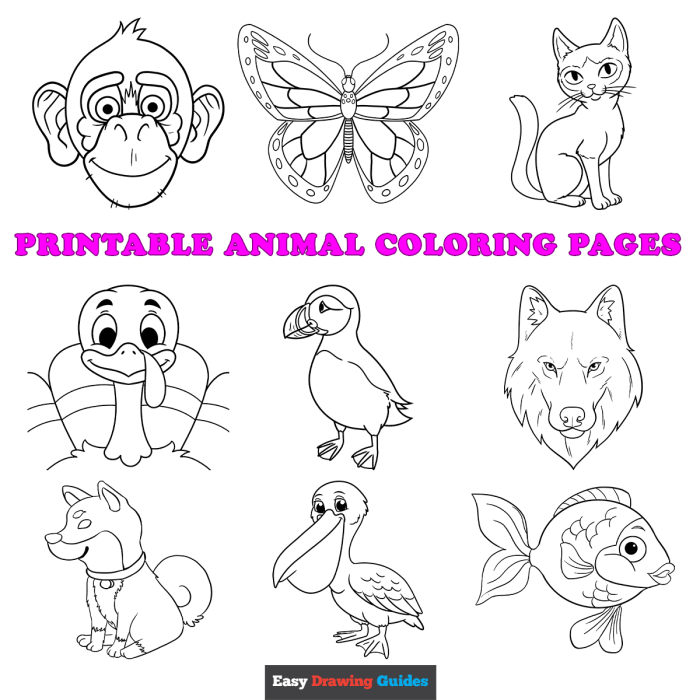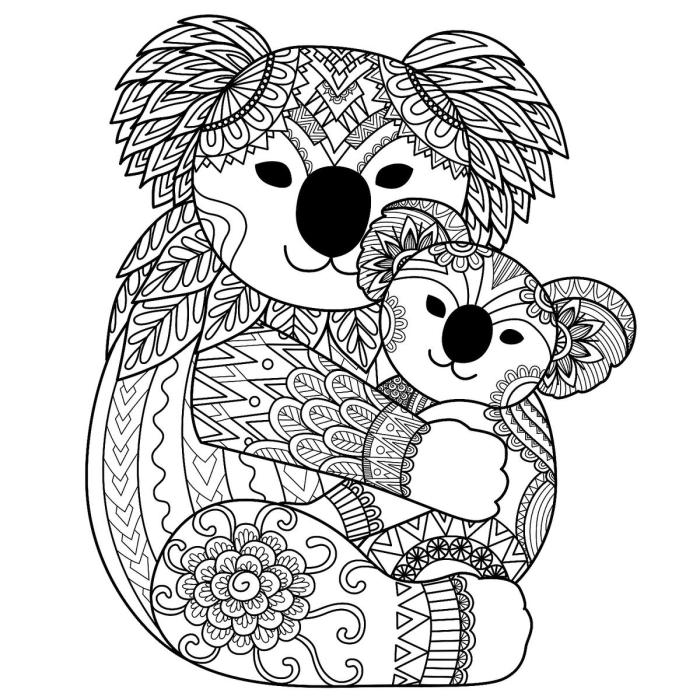Animal Categories & Variety

Detailed coloring pages printable animals – Choosing the right animals for detailed coloring pages requires careful consideration of their visual appeal and the level of detail achievable for different age groups. A diverse range of animals ensures broad appeal and provides opportunities for creative expression. The selection should balance familiar favorites with more unusual creatures to stimulate interest and learning.
The following table categorizes animals suitable for detailed coloring pages, highlighting their unique characteristics that make them engaging for coloring enthusiasts.
Animal Category Table
| Category | Description | Coloring Appeal | Example Animals |
|---|---|---|---|
| Farm Animals | These animals are familiar and often feature soft textures and simple shapes, ideal for beginners. | Varied textures (fur, feathers), simple shapes, opportunity for vibrant colors. | Cows, pigs, sheep, chickens, horses |
| Wild Animals (Mammals) | These animals offer a wide range of shapes, sizes, and markings, allowing for intricate detail. | Complex patterns, diverse fur textures, opportunities for shading and blending. | Lions, tigers, bears, elephants, wolves |
| Wild Animals (Birds) | Birds offer vibrant plumage and varied beak and wing shapes, making them visually striking. | Bright colors, intricate feather patterns, opportunity for detailed beak and wing design. | Parrots, peacocks, eagles, owls, hummingbirds |
| Sea Creatures | These animals offer a unique opportunity to explore textures and scales, along with vibrant colors. | Scales, fins, unique body shapes, opportunity for gradients and water effects. | Dolphins, whales, sharks, sea turtles, jellyfish |
| Insects | Insects provide intricate detail in their exoskeletons and wings, perfect for advanced colorists. | Exquisite detail in wings and body segments, opportunity for vibrant and contrasting colors. | Butterflies, ladybugs, dragonflies, beetles, ants |
| Reptiles | Reptiles offer unique textures and patterns on their scales, making them ideal for detailed work. | Scales, patterns, unique body shapes, opportunity for realistic shading. | Snakes, lizards, crocodiles, turtles, chameleons |
| Amphibians | Amphibians offer a range of textures and colors, from smooth skin to bumpy warts. | Skin textures, varied colors, opportunity for highlighting moisture. | Frogs, toads, salamanders, newts |
| Domestic Pets | Cats and dogs offer familiar and endearing subjects, perfect for all ages. | Fur textures, expressive eyes, opportunity for personalization. | Cats, dogs, rabbits, hamsters |
| Mythical Creatures | Dragons, unicorns, and griffins allow for creative freedom and imaginative coloring. | Unique features, opportunity for imaginative color combinations, blending of animal characteristics. | Dragons, unicorns, griffins, phoenixes |
| Dinosaurs | Dinosaurs offer a combination of familiar and fantastical elements, appealing to a wide audience. | Scales, unique body shapes, opportunity for vibrant colors and imaginative interpretations. | Tyrannosaurus Rex, Triceratops, Stegosaurus, Brachiosaurus |
Coloring Page Layouts
The following descriptions detail three different layouts for coloring pages, showcasing diverse animal groupings from the categories listed above.
Layout 1: “Jungle Jamboree” This layout features a vibrant jungle scene with a monkey swinging from a vine, a brightly colored parrot perched on a branch, a jaguar hidden in the foliage, and a toucan peeking from behind a large leaf. The scene is designed to encourage creative use of color and texture, with varying levels of detail for different skill levels.
The background includes lush vegetation and a flowing river, adding to the overall complexity and visual interest.
Layout 2: “Under the Sea Adventure” This layout depicts a coral reef teeming with life. A playful dolphin leaps from the water, a majestic sea turtle glides along the ocean floor, a brightly colored clownfish hides amongst the anemones, and a stealthy shark lurks in the shadows. This layout focuses on the contrast between vibrant coral and the darker, more mysterious depths of the ocean, providing opportunities for exploring different color palettes and shading techniques.
Dive into the delightful world of detailed coloring pages printable animals; from majestic lions to playful puppies, the possibilities are endless! If you’re looking for a slightly different style, consider the adorable charm of anime coloring pages cute , before returning to the intricate details of realistic animal coloring pages. It’s a fantastic way to explore different artistic styles and unleash your creativity!
The detailed coral formations provide a complex background that adds to the overall visual interest.
Layout 3: “Farmyard Fun” This layout showcases a cheerful farm scene with a friendly cow grazing in a field, a playful pig rolling in the mud, a fluffy sheep looking over a fence, and a proud rooster crowing. This layout focuses on simple shapes and textures, making it suitable for younger children. The background includes a rustic barn and a sunny sky, creating a warm and inviting atmosphere.
The use of muted colors for the farm setting allows the animals’ brighter colors to stand out.
Printable Page Considerations

Creating truly engaging and high-quality printable coloring pages requires careful consideration of several key factors beyond just the artwork itself. The paper choice, its size, and the resolution of the digital file all significantly impact the final printed product, affecting both the coloring experience and the longevity of the finished piece. Let’s delve into the specifics to ensure your animal coloring pages are a roaring success.Paper size and resolution are fundamental to achieving a sharp, detailed print.
A larger paper size allows for more intricate designs and comfortable coloring space, while a higher resolution ensures the lines remain crisp and clear, preventing pixelation or blurring. For detailed animal coloring pages, aiming for at least 8.5 x 11 inches (letter size) is recommended, although larger formats (like A3 or even larger) offer even more space for creativity, particularly with complex designs.
A resolution of at least 300 DPI (dots per inch) is crucial for maintaining detail; anything lower will likely result in a noticeably lower quality print.
Paper Type Selection, Detailed coloring pages printable animals
The choice of paper significantly impacts the coloring experience. Regular printer paper, while readily available and inexpensive, can be thin and prone to bleeding, especially with wet media like markers or watercolors. This can lead to frustration for the colorer and a less satisfying final product. Cardstock, on the other hand, is thicker and more durable, offering better resistance to bleeding and tearing.
Its sturdier nature also makes it suitable for more vigorous coloring techniques and allows for layering of colors without the risk of the paper becoming too thin or damaged. While cardstock is more expensive, its superior quality often makes it a worthwhile investment, particularly for detailed coloring pages intended for younger children or for those who prefer to use vibrant, wet media.
Printing Checklist
Before committing to printing a batch of detailed animal coloring pages, a quick checklist can save time, ink, and frustration.
- Ink Levels: Check your printer’s ink levels. Low ink can lead to faded colors and incomplete prints, particularly in detailed areas. A simple print preview can often highlight potential issues.
- Printer Settings: Ensure your printer is set to the correct paper size and resolution (at least 300 DPI). Selecting the “best” or “high-quality” print setting is generally recommended for detailed images. Experiment with different settings to find the optimal balance between quality and printing speed.
- Test Print: Always perform a test print on a single sheet before committing to a full print run. This allows you to check for color accuracy, sharpness, and any unexpected issues with bleeding or smudging before wasting a large amount of paper and ink.
- File Format: Ensure your coloring page file is in a suitable format, such as JPEG or PNG, that your printer can handle effectively. PDFs are generally well-suited for preserving high-resolution images.
- Paper Tray: Confirm that the correct paper type is loaded into the printer’s paper tray. Using the wrong type of paper can lead to jams or suboptimal print quality.
Illustrative Examples & Descriptions: Detailed Coloring Pages Printable Animals

These examples demonstrate the level of detail achievable in creating printable animal coloring pages. The aim is to provide engaging designs that challenge and stimulate creativity while offering a rewarding coloring experience. Each example highlights specific features and techniques to consider when designing your own pages.
Lion Coloring Page
The detailed lion coloring page would offer a captivating challenge for colorists of all ages. The intricate design allows for expressive coloring choices and emphasizes the majestic nature of the animal.
- Mane: The lion’s mane should be rendered with individual strands, varying in length and thickness, allowing for nuanced shading and highlighting. Consider incorporating lighter areas within the mane to suggest sunlight filtering through. The base color could be a rich tawny, with darker shades added for depth and texture.
- Paws: The paws should be depicted with clearly defined pads and claws. The texture of the fur on the paws should be different from the body fur, suggesting a coarser texture. Consider adding shadows between the toes and pads to enhance realism.
- Facial Features: The eyes should be large and expressive, with carefully defined pupils and highlights. The nose should be realistically shaped, with nostrils clearly visible. The mouth should be slightly open, revealing teeth and a hint of tongue. Careful attention should be paid to the whiskers, which should be individually rendered.
Elephant Coloring Page
This coloring page focuses on the elephant’s unique physical characteristics, allowing for exploration of texture and form. The intricate details will engage the colorist and provide a satisfying coloring experience.
| Body Part | Texture Description | Color Suggestions | Detail Considerations |
|---|---|---|---|
| Skin | Rough, wrinkled, with deep creases and folds. Show variations in texture across the body. | Shades of grey, ranging from light to dark, with hints of brown or pink in certain areas. | Incorporate shading to emphasize the wrinkles and folds. |
| Trunk | Long, flexible, with a rough surface texture. Show the flexibility by including subtle curves and bends. | Darker grey than the body, with lighter areas to suggest highlights. | Include detailed lines to suggest the trunk’s musculature and flexibility. |
| Ears | Large, fan-like, with intricate vein patterns. | Similar shades to the body, but with variations to suggest depth and texture. | Render the veins with fine lines, adding depth and realism. |
| Tusks | Smooth, ivory-colored, slightly curved. | Off-white or creamy white, with subtle shading to highlight the curves. | Pay attention to the smooth surface and slight curvature of the tusks. |
Butterfly Coloring Page
The butterfly coloring page emphasizes the delicate beauty and intricate wing patterns of this insect. The color suggestions aim to inspire creativity and enhance the overall aesthetic appeal.
- Wings: The wings should be depicted with elaborate patterns, incorporating symmetrical and asymmetrical designs. Consider using a variety of shapes, including circles, swirls, and lines.
- Wing Patterns: The patterns should be intricate and detailed, with a variety of colors and textures. Suggestions include radial patterns, concentric circles, and abstract designs.
- Body Segmentation: The body should be clearly segmented into the head, thorax, and abdomen. The antennae should be long and delicate, with subtle curves and bends.
- Color Suggestions: Vivid and contrasting colors are encouraged, such as blues, greens, yellows, oranges, and purples. Consider using metallic or iridescent shades to add a touch of magic.
- Legs and Antennae: The legs should be thin and delicate, while the antennae should be long and slender. These features should be clearly defined and detailed.
